What Is a Self-Serve DSP? A Comprehensive Guide
Self-serve DSPs offer marketers and advertisers control and efficiency, but choosing the right one for your business can be tricky, as multiple options are available. Whether you want total autonomy, flexibility, or full-service support, we’ll help you identify the best self-serve DSPs and highlight their unique advantages.
In this article, we’ll explain what self-serve DSPs are, break down the key differences between different types of DSP platforms, and gather insights from industry experts.
Let’s get started!
What is a self-serve DSP?
For a quick recap, a DSP is a critical tool in programmatic advertising that enables advertisers to purchase digital ad space through real-time bidding across various ad exchanges. However, different types of DSPs are tailored to different business needs–self-serve, white-label, and managed service DSPs.
But we’ll delve into that a bit later.
A self-serve DSP allows marketers and advertisers to directly manage their digital ad campaigns. It gives advertisers full control over the entire process–from campaign setup and targeting to optimization and reporting–without relying on third-party management.
Main benefits of Self-Serve DSPs
Here are the 6 main benefits of self-serve DSPs and key insights on their significance from advertising and marketing experts:
Control and flexibility
Self-serve DSPs put advertisers in the driver’s seat, giving them full control over their campaigns. This allows advertisers to fine-tune targeting, budget allocation, and real-time adjustments without the need for intermediaries.
- Laia Quintana, head of marketing and sales at TeamUp, highlights that self-serve DSPs have enhanced targeting capabilities, providing advertisers with more precise audience segmentation and real-time adjustments, making it a preferred choice for smaller businesses.
- Eli Itzhaki, CEO and founder of Keyzoo, shared that using platforms like The Trade Desk allowed him to refine targeting down to specific demographics, which was a game-changer.
Cost efficiency
By removing third-party intermediaries, self-serve DSPs help advertisers save money and allocate more of their budgets to actual media buying, resulting in better ROI.
- Michael Schmied, senior financial analyst at Kredite Schweiz, emphasized that SMBs can manage their own advertising campaigns without hiring external agencies, making these platforms extremely cost-efficient.
- Kevin Huffman, owner of Kriminil Trading, adds that the removal of intermediaries means advertisers now get more transparency and control over their ad spend, leading to increased cost efficiency.
Automation and innovation
Self-serve DSPs integrate automation tools, such as machine learning and AI, to optimize ad placements and improve campaign outcomes without the need for constant manual intervention.
- Jeremy Bogdanowicz, founder and CEO of JTB Studios, notes the progress platforms like StackAdapt have made in combining control and automation: “They offer a good mix of control and automation, appealing to advertisers who want both precision and performance.”
- Tommy Le, founder of Poshwatch, praised StackAdapt’s machine learning capabilities, saying, tools like geolocation, in-app data, and ADID tracking help advertisers gain valuable insights and improve performance.
Skill development and democratization
Self-serve DSPs provide an opportunity for advertisers to enhance their programmatic skills, making advanced advertising technologies accessible to a broader range of users.
- Matt Little, founder and managing director of Festoon House, noted the evolving sophistication of DSPs, mentioning Amazon and Google Display & Video 360 both offer self-serve options that simplify ad buying and allow for broader access to programmatic advertising.
Transparency and insights
Advertisers benefit from transparency in reporting and analytics, which allows them to monitor campaign performance and make data-driven decisions.
- Alfred Christ, Digital Marketer at Robotime, shared how The Trade Desk’s transparency in reporting and control over ad placements has improved ROI and provided critical insights into customer behavior.
- Rasa Urbonaite, the CMO of Breezit, pointed out that Yahoo! DSP’s comprehensive measurement tools equip advertisers to effectively reach their target audience while offering great transparency in a cookieless environment.
Self-serve DSPs in today’s advertising landscape
Self-serve DSPs offer control, cost efficiency, automation, skill development, and transparency–all of which enable advertisers to manage their campaigns more effectively.
They are reshaping how businesses approach programmatic advertising by making it more accessible, cost-efficient, and transparent. They also empower businesses of all sizes to participate in digital advertising without relying on intermediaries, allowing for greater control over budgets and targeting.
This democratization enables small and medium-sized businesses to compete effectively in the market.
How Do Self-Serve DSPs Work?
Self-serve DSPs give advertisers direct access to programmatic ad buying through a user-friendly platform. Here are 3 main steps that help to illustrate how they work:
- Advertisers sign up for the DSP and gain access to a dashboard. They configure their campaign settings, including budget, audience targeting (e.g., demographics, interests, location), and ad formats (e.g., display, video, mobile).
- The advertiser uploads the ad creatives (such as banners or videos) into the platform.
- The DSP uses real-time bidding (RTB) technology to automatically place bids on ad impressions from various ad exchanges. Advertisers can set bidding strategies and control the amount they are willing to spend for specific impressions.
Advertisers can monitor the campaign’s performance using real-time analytics, adjusting their strategies by optimizing bids, changing targeting parameters, or updating creatives based on performance data.
Additionally, self-serve DSPs often feature automated tools, such as AI-driven bidding and audience segmentation, to enhance efficiency.
Key Features of a Self-Serve DSP
Self-serve demand-side platforms are designed to give advertisers full control over their programmatic advertising campaigns, offering a range of features that streamline the ad buying process.
Below you can see the 4 key features that define a powerful self-serve DSP.
1. User-friendly interface
A user-friendly interface is crucial for self-serve DSPs, as advertisers are expected to manage their campaigns without intermediaries. The interface should be intuitive, allowing users of all technical skill levels to navigate through campaign creation, optimization, and reporting easily.
Most platforms focus on simplicity in campaign setup, drag-and-drop features for creative uploads, and clear instructions for managing targeting and bidding options. Having robust customer support and tutorials also plays a part in easing the learning curve.
Notable Examples:
- Google Display & Video 360 (DV360) offers an easy-to-use dashboard for both beginners and advanced users, with integrated access to YouTube inventory, premium ad formats, and audience data.
- StackAdapt is known for its streamlined interface that enables smooth navigation for users, even when managing multiple channels.
2. Audience targeting capabilities
The power of a DSP lies in its audience targeting options. Advertisers can reach specific demographics, geographic locations, and interest-based groups. Advanced platforms often offer lookalike audiences, behavioral targeting, contextual targeting, and retargeting based on first-party or third-party data.
Some DSPs, like The Trade Desk, allow advertisers to create highly customized audience segments, integrating data from multiple sources to refine their targeting.
Other DSPs, such as Yahoo! Advertising DSP, provide similar levels of customization, emphasizing cookie-less targeting options.
3. Bidding strategies and controls (CPM, CPC, CPA)
Effective self-serve DSPs provide a variety of bidding strategies tailored to meet different campaign goals. The most common models are:
- Cost per mille (CPM): Cost per thousand impressions, commonly used for brand awareness campaigns.
- Cost per click (CPC): Charges based on the number of clicks an ad receives, ideal for performance-driven campaigns.
- Cost per action (CPA): Charges based on specific actions, like a purchase or sign-up, and is preferred for conversion-focused campaigns.
MediaMath and Google DV360 offer automated bidding strategies that use machine learning to optimize bids in real time based on performance data, helping advertisers achieve their campaign goals with better efficiency.
4. Real-time reporting and analytics
Real-time reporting is a core feature of self-serve DSPs, allowing advertisers to monitor campaign performance continuously and adjust strategies as needed. Advanced platforms offer detailed insights into key metrics such as impressions, click-through rates, conversion rates, and return on ad spend (ROAS).
Google DV360 stands out for its in-depth reporting capabilities, integrating with Google Analytics 360 for a comprehensive view of user behavior across campaigns. Similarly, The Trade Desk and StackAdapt provide real-time dashboards with granular data that support rapid optimizations.
Why Choose a Self-Serve DSP?
When thinking about a self-serve DSP, you need to evaluate your specific advertising needs and the advantages of such a platform.
Self-serve DSPs empower advertisers by providing direct control over their digital advertising campaigns. They are well-suited for businesses with some programmatic advertising experience and prefer to manage campaigns in-house.
Here’s a detailed look into why a self-serve DSP might be the right choice for you:
Cost efficiency
One of the primary advantages of using a self-serve DSP is cost efficiency. Self-serve DSPs allow advertisers to maximize ad spend by eliminating third-party management costs, ensuring that more of their budget goes directly toward media buying rather than service fees.
Since you manage your campaigns independently, you avoid the additional fees associated with managed services. This makes it an ideal choice for businesses with tighter budgets but significant ad needs.
Full control over campaigns
Self-serve DSPs give advertisers full control over every aspect of their campaigns, from budget allocation to targeting and bidding strategies. This control is invaluable for advertisers who want to closely monitor performance and make real-time adjustments.
This level of control also allows for precise optimization based on real-time data, which can lead to better campaign outcomes and more effective ad spending.
Flexibility and customization
With a self-serve DSP, you have the flexibility to customize your campaigns according to your specific needs. Whether it’s setting up detailed targeting parameters, adjusting bids, or testing different ad creatives, self-serve DSPs provide the tools needed to tailor campaigns to your unique objectives.
This flexibility is especially beneficial for mid-sized agencies or businesses that need to frequently adapt their strategies to changing market conditions.
Speed and agility
Self-serve DSPs allow advertisers to quickly implement and adjust campaigns without waiting for third-party approval or intervention. This agility means you can respond to market trends, optimize campaigns in real-time, and capitalize on opportunities as they arise, ensuring that the advertising efforts remain effective and competitive.
Challenges of Using Self-Serve DSPs
While self-serve DSPs offer cost savings, flexibility, and control, they require users to overcome a significant learning curve, manage complex systems, and stay updated with evolving technology.
The learning curve
Self-serve DSPs offer great control but come with a steep learning curve, especially for users new to programmatic advertising.
These platforms are packed with complex features like real-time bidding, audience segmentation, and campaign optimization. Advertisers often need time to familiarize themselves with the platform’s settings and strategies, making it hard for beginners to fully leverage the potential of their campaigns.
This learning phase can delay the time it takes to see significant results and may require continuous education on how to optimize ad performance.
Managing complexity
Self-serve DSPs allow you to handle targeting, budgeting, and bidding manually, which can be overwhelming for users without experience in digital advertising. The complexity lies in monitoring campaign metrics, understanding audience behaviors, and fine-tuning campaigns in real-time.
Advanced features like A/B testing and dynamic creative optimization also require technical know-how to implement effectively.
Budget and resource constraints
Although self-serve DSPs are more cost-efficient than managed services, they still require significant resource investment. Advertisers must dedicate time and people to manage campaigns, which might not always work well for smaller teams.
Additionally, while the platform’s cost may be lower, there is the potential for budget mismanagement, especially for new users who may not be familiar with optimizing ad spend efficiently.
Keeping up with technology
Digital advertising technologies are constantly evolving, and self-serve DSP users need to keep up with the latest advancements to remain competitive. Changes in targeting algorithms, the introduction of new ad formats, or compliance updates require users to stay informed and adapt quickly.
Failure to do so can lead to missed opportunities or even non-compliance, which could negatively impact campaign success or result in fines.
Self-Serve DSP vs. White-Label DSP vs Managed Service DSP
A self-serve DSP is designed for advertisers who prefer direct control over their advertising campaigns. It provides a user-friendly interface where advertisers can independently set up, manage, and optimize their campaigns. The main benefits include cost efficiency, flexibility, and control.
This type of DSP is ideal for small to medium-sized businesses or individual marketers who have the expertise and time to manage their own campaigns.
A self-serve DSP is particularly suited if:
- You have an in-house team with the skills to manage and optimize programmatic campaigns.
- Your budget is constrained, and you want to ensure that most of it goes directly into media buying rather than service fees.
- You require flexibility and speed in managing your campaigns, allowing for quick adjustments and real-time optimizations.
- You desire full control over your campaigns, from strategy to execution.
| Features | Self-serve DSP | White-label DSP | Managed service DSP |
| Control | Full control over campaigns and settings | Complete control, branded as your own platform | Limited control; campaign managed by a third-party team |
| Customization | Limited, standard features with customizable options | Highly customizable; tailor features and branding | Little to no customization; depends on service provider |
| Audience targeting | Advanced targeting options like demographics, behavior, location | Same as self-serve, but requires integration with SSPs | Varies based on the service provider’s capabilities |
| Technical expertise needed | Moderate to high expertise required | High expertise needed for setup and ongoing management | Low expertise needed from the client, provider handles management |
| Ad spend management | Direct control over ad spend, with the ability to adjust in real-time | Managed internally, with potential for tech fees | Managed by the third-party, with limited client involvement |
| Ideal users | Best for businesses that want complete control and have the in-house knowledge to manage campaigns | Ideal for agencies or large brands wanting to operate under their own control over the technology | Suit businesses that need expert assistance and prefer to focus on strategy rather than execution |
White-Label DSPs
A white-label DSP is a more customizable option, allowing businesses to brand and configure the DSP platform (e.g, Teqblaze). This type of DSP provides more extensive control over the platform’s features, user experience, and integrations.
It suits agencies or large enterprises looking to scale their programmatic capabilities under their brand. While it offers greater flexibility and potential cost savings in the long run, a white-label DSP typically requires higher initial investment and more technical expertise to manage effectively.
This solution is best for businesses that want to bring programmatic operations in-house and maintain complete transparency and control over their advertising activities.
Managed Service DSPs
A managed service DSP is for advertisers who prefer to outsource the management of their campaigns to professionals. The DSP provider’s team handles everything from strategy and setup to optimization and reporting in this setup (e.g., GourmetAds)
This option is less hands-on for the advertiser but comes with higher costs due to service fees. Managed service DSPs are ideal for businesses that lack the in-house expertise or resources to manage complex programmatic campaigns or those that prefer to focus on other aspects of their business while leaving the technical work to experts.
6 Top Self-Serve DSPs
1. Google Display & Video 360
Google DV360 offers a unified platform that combines display, video, mobile, TV, and other ad formats. Its self-serve capabilities provide advertisers with advanced audience targeting, access to premium inventory, and comprehensive creative tools.
It also integrates seamlessly with Google’s ecosystem, offering in-depth analytics through Google Analytics and Campaign Manager. The platform is ideal for larger-scale advertisers, offering features like private marketplace deals, robust targeting options, and detailed reporting.
However, it tends to have higher minimum spend requirements compared to other DSPs.
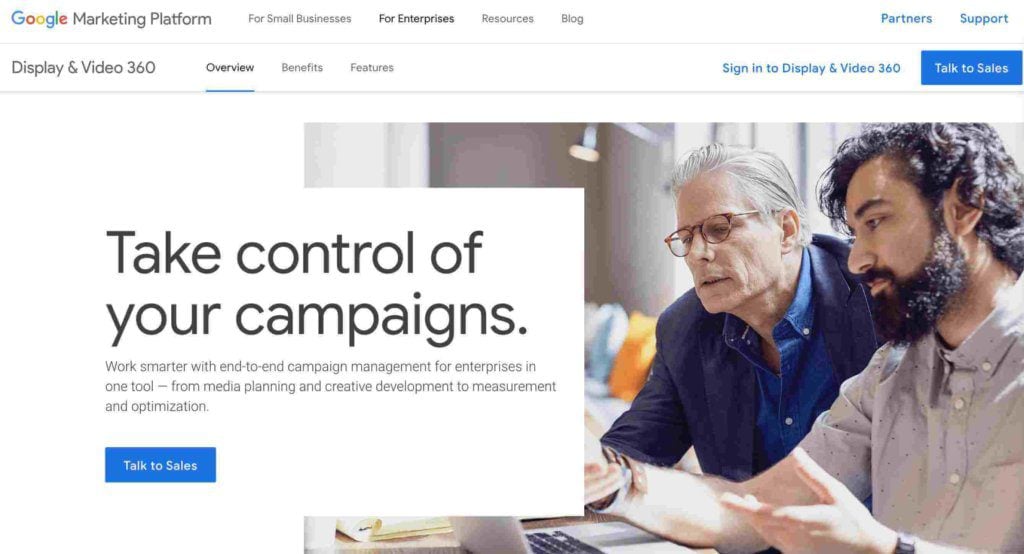
2. Yahoo! Advertising DSP
Yahoo! Advertising DSP offers a strong self-serve platform with extensive reach across Yahoo properties and partner sites. It provides advanced targeting options, premium inventory access, and comprehensive measurement tools. With multiple ad formats such as display, video, and native, Yahoo! DSP is designed to deliver high performance across different devices and formats.
It’s especially valuable for advertisers seeking premium content and transparency in their campaigns.
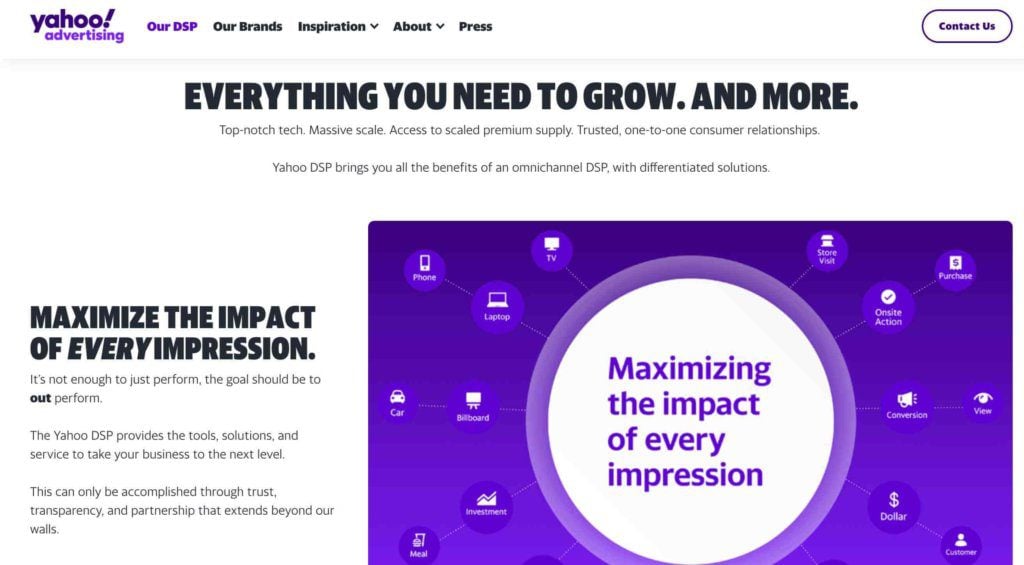
3. StackAdapt DSP
StackAdapt is known for its user-friendly interface and powerful automation capabilities, making it ideal for native advertising and programmatic buying. It excels in integrating machine learning for optimization, offering advanced audience targeting, and reporting tools.
Its self-serve platform supports multiple ad formats, including display, native, video, and CTV, making it a popular choice for advertisers who want hands-on control with minimal complexity.
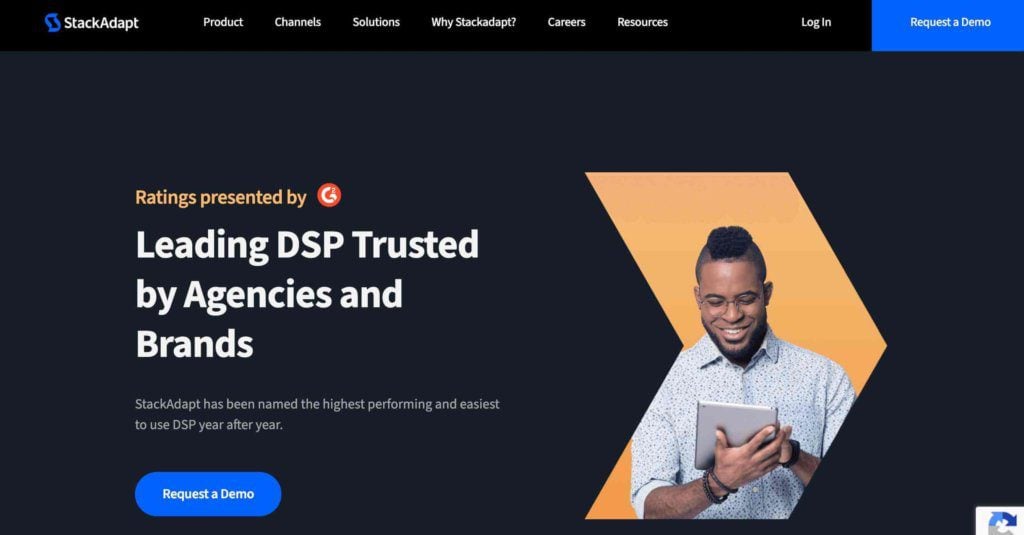
4. The Trade Desk
The Trade Desk has one of the most popular self-serve DSPs, providing advertisers with deep control over programmatic campaigns. Known for its global reach, the platform offers robust targeting options, precise bid management, and real-time reporting. It’s especially favored for its advanced data analytics and integrations with multiple data sources, which allow for effective cross-channel campaigns.
The Trade Desk is highly scalable, though it typically requires higher minimum ad spends.
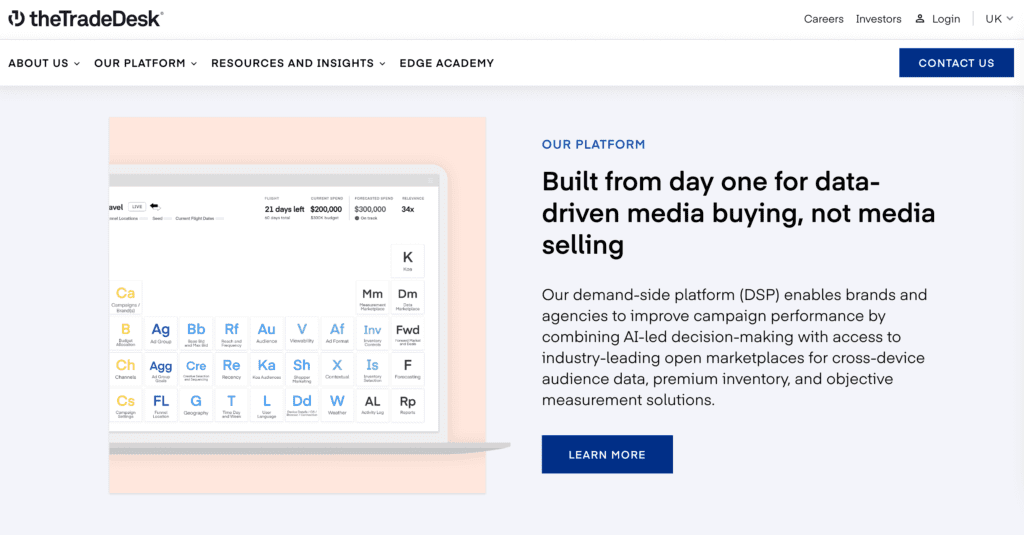
5. MediaMath
MediaMath stands out for its strong optimization algorithms and wide network of SSP partners. The platform excels in multi-channel campaigns across display, video, and mobile, offering advanced targeting and audience segmentation.
Its self-serve interface is designed for experienced advertisers who want to manage campaigns with detailed control over ad performance and creative execution.
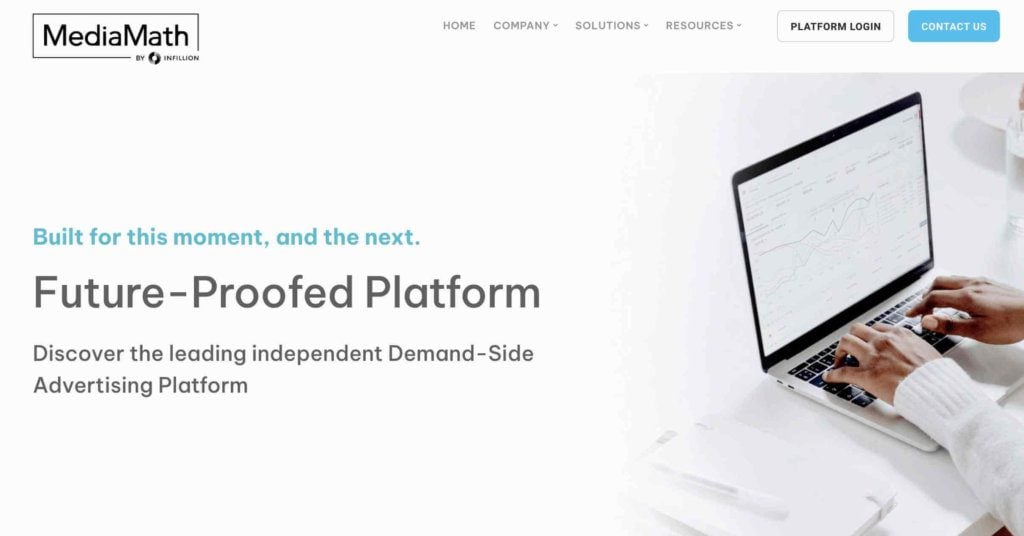
6. SmartyAds
SmartyAds offers a flexible and cost-efficient self-serve DSP tailored for small to medium-sized businesses. It supports various ad formats, including display, video, native, and mobile, providing robust audience targeting and real-time reporting.
SmartyAds is known for its transparency and scalability, making it a good option for advertisers looking to run efficient programmatic campaigns without the need for extensive technical expertise.
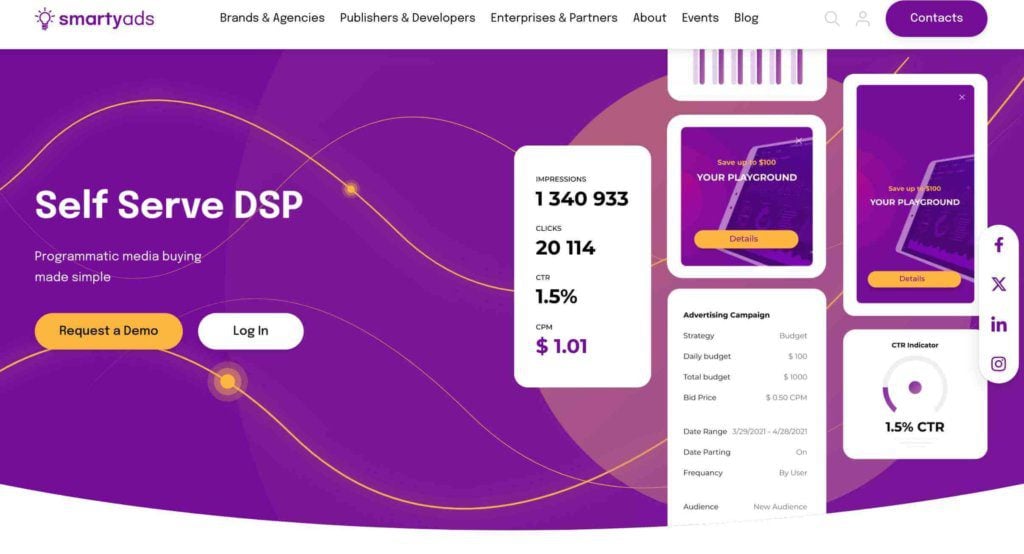
Conclusion
In a nutshell, self-serve DSPs give advertisers complete control over their campaigns, offering features like advanced audience targeting, real-time bidding, and automated campaign optimization.
These platforms provide cost-efficient and transparent solutions for businesses of all sizes.
Whether you’re a small business looking to break into digital advertising or a large company seeking to streamline operations, self-serve DSPs help you to reach the right audience, optimize ad spend, and enhance performance. All without relying on third-party intermediaries.
With the right platform, advertisers can manage campaigns more effectively, driving better results and achieving greater ROI.
FAQs
What is a Self-Serve DSP, and how does it differ from a managed DSP?
A Self-Serve DSP allows advertisers to control all aspects of their campaigns, including budgeting, targeting, and optimization, without third-party intermediaries. In contrast, a managed DSP is operated by a service provider who handles campaign management on behalf of the advertiser, offering less direct control but more hands-on service.
How can I determine if a self-serve DSP is right for my business?
A self-serve DSP is ideal if you want full control over your campaigns, have the technical expertise or team to manage them, and are focused on optimizing ad spend efficiently. It’s also suitable if you want to avoid additional service fees associated with managed DSPs.
What are the risks associated with using a self-serve DSP?
The main risks include mismanaging budgets, improperly setting targeting parameters, and requiring a significant learning curve, especially for those unfamiliar with programmatic advertising.
How much technical knowledge do I need to use a self-serve DSP effectively?
Moderate to high technical knowledge is needed. You must understand campaign setup, audience targeting, bidding strategies, and analyzing performance data to maximize effectiveness.
Can small businesses benefit from using self-serve DSPs?
Yes, small businesses can benefit from self-serve DSPs due to lower costs, full control over ad spend, and the ability to compete in programmatic advertising without relying on external agencies.
What are some of the top self-serve DSP platforms available today?
Top platforms include Google Display & Video 360, The Trade Desk, StackAdapt, MediaMath, Yahoo! DSP, and SmartyAds.
How do self-serve DSPs ensure data privacy and compliance with regulations?
Most self-serve DSPs comply with regulations like GDPR and CCPA by offering features like data anonymization, consent management, and integration with third-party verification tools to ensure data privacy.


